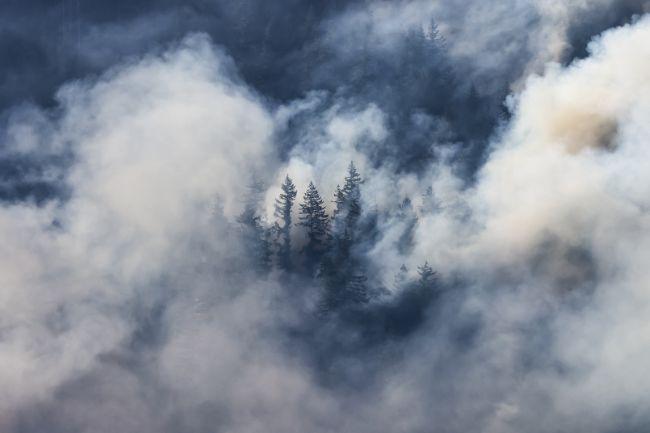By Danny Flannery
On April 7, Dr. Janelle Burke, Earth, Environment and Capital (E3) intermediate chair and atmospheric sciences Dr. Joseph Wilkins and Dr. Osinachi Ajoku Howard was held an extreme air symposium within the month of the investigation. During the event, E3 research teachers and employees of E3 are research on research on urgent problems created by MININEY from Guinea
Leading guests, Wilkins, fire modeling, emphasizing that the climate change in climate change, such as “Wal”, the need to learn to adapt to climate change (rapidly growing water pollution, air pollution and life effects). “We need to learn how to live with the earth,” he said, focusing on wild flames as an example. “Earth is a necessary process in the fire, but like people, I would also call the negative types of fire. We must find a refined balance between driven burns and burning burns on earth.”
He said, “We are here to build a cooperation, we are here to hear new ideas or older ideas and are here to solve these difficulties,” he said.
Research between subjects and oceans
The spirit of this cooperation was clear from the width of the subjects represented by the dynamics from the dynamics to sociologists from biologists to sociologists to sociologists. The potential impact of their work has been expanded in a similar way to better evacuation plans for better evacuation plans for decades for decades.
For example, Ajoku’s research focuses on aerosols – the part of a liquid or gas, such as a smoke due to the African climatic dynamics, or the particles suspended. These particles may have a mass effect on the planet by scattering or scattering radiation directly from the sun and indirectly by serving radiation or indirectly.
“I said that the aerosols were one of the most important sciences in the world, because whenever every cloud looks at the center, there is nothing like a aerosol, there is no such thing without aerosols.”
In particular, Ajoku’s investigation, in Central Africa, how the region’s rainfall regulates rainfall, in central Africa affects a large bioting incidents. We find a great difference in Ajoku, in “pile” days (dirty “days (dirty” days (dirty “days (dirty” days (dirty “days.
With the regional population of more than 200 million people, this research is invaluable in understanding the risks of floods or drought.
Third year Ph.D. Researcher Alycia Triplett introduced the opportunity to learn and training in the National Ocean and Atmospheric Administration (NOAA) in the NOAA Laboratory of Global Systems. During the summer, Triplett worked in a platform for the transition to the tested weather conditions, use of fire weather conditions, commissioned technologies, products and communication strategies. During his experience, his work helps to close the important communication cavity to make the societies greed.
“Fire warnings do not work as a typical tornado or flash flaw warning,” Because because of the policy fires in the ground, “it is considered non-air warning.” This means that the National Weather Service (NWS) is required only by local or government officials, means delayed responses or confusion for community members in emergencies.
Triplett has helped to test fire warnings to integrated warning groups of NWS. Typically, these teams, including both forecasts and emergency managers, sheriffs, heads and others, allow meteorologists and emergencies to better coordinate in extreme weather events.
Five land managers from the assessment, four meteorologists and California, Kansas, North Carolina and Florida, were combined to confirm and coordinate fires and to coordinate and warn the public. Among the seven sessions, the teams were successfully associated with 72 simulated fire.
Social and behavioral sciences were woven through working groups, pre-evaluation inquiries, pre-evaluation requests and official focus groups and the main attention of Triplettin’s work. The opinions of both scientists and land managers will be invaluable for communities facing wild flames.
Pay attention to the community
Doctoral candidate Lauren Taylor’s conversation, “After the fire: Lahaina’s health difference and environmental injustice” investigated the need to adapt to new environmental realities.
“This is how we see since the early 2000s, this is about 70,000 wild fire a year, which is very much,” Taylor said. “But those who are very interested in me do not really grow, but we see, the growing growing in the field of planting in the field of originally lasts until September.”
Hawaii, Hawaii, Hawaii’ın a society of 2023 wildlife investigating the wildlife, was directed to the situation of influence and restoration. The ratio of Lahaina’s poverty is higher than the average, black and Spanish populations of both the national average and the city, in the middle of the city’s native Hawaii, black and Spanish populations. More than 2,000 structures were destroyed during the fire, 86% of the residential building and 30% of these homes are below the poverty line. Only six of these houses were reconstructed.
Taylor’s research shows that people with the least recipe for those who are at least the lowest reserve of extreme air – people in poverty and minority groups. Outside of the lack of resources, these communities face more risks to the lack of confidence in higher degrees of health complications and institutions such as FOMA and the violence of an incident.
Lauryn Smith, a master’s candidate at the Department of Atmospheric Sciences, said this ending point was discussing 2024 Canadian Canadian fire extinguishers in a strong smoke last year. Using the information collected from the tools in the Tools in Beltsville, Smith, including black carbon, sulfur dioxide and carbon monoxide on June 6-8, 2024, showed the same as low-pressure trough and extraordinary dry winds.
Despite these dangerous materials, Smith’s presentation is the photos of people passing the smoke. He said in a Q & A: Because they surrendered to society, I see an issue with the communication of the violence of such events. For people who do not know anything, they need education and know they go outside. “
The increase in excessive weather, emergency, complex threats, which is very complex, which is completely understood by one person, can present complex threats. However, the location of howard’s location, surroundings and capital departments provide a way for possible solutions, out of this, Thing-Thing-Thing, interdisciplinary cooperation and strongest ties to the most affected communities.
“You probably don’t know if you don’t know you,” I don’t know if I tried to calm you. You don’t know if you don’t know “don’t feed closed mouths.” But I know you know a friend, a friend, a friend who knows a friend, a friend. Why don’t you start with them? “




